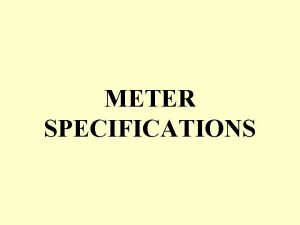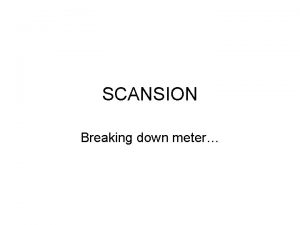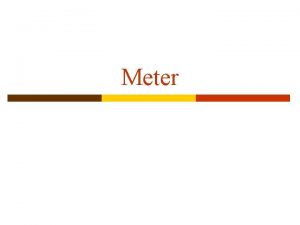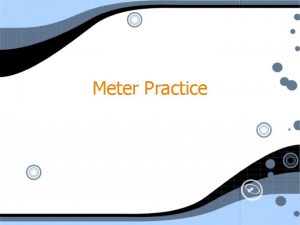The Friendship Meter Logic of Friendship 1 You















- Slides: 15

The Friendship Meter


Logic of Friendship 1. You can be my friend if you are trustworthy and loyal and brave. 2. You can be my friend if you are trustworthy and like baseball or ice hockey. 3. You can be my friend if you like cooking or baseball or jazz music.

Friendship Meter Procedure 1. 2. 3. 4. 5. 6. 7. Brainstorming Logic Diagram Wiring Diagram Circuit Simulation Circuit Construction and Testing Presentation Reflection Paper

Brainstorming Procedure 1. Identify qualities of a good friend. Brainstorm a list of things that you find important in a good friend. 2. Identify possible materials you can use for the construction of your friendship meter. – – All meters will be powered by a 9 -Volt battery. Holiday lights will be provided At least one thing related to your program area must be incorporated into your meter At least one thing related to your “Friendship List” must be incorporated into your meter

Logic Diagram Procedure 1. Choose at least four traits that you want to use for your Friendship Meter. You can choose more but you must have at least four. 2. Identify each trait as either exclusive (an and statement) or not exclusive (an or statement) 3. Write questions that clearly show the relationship between the trait and whether or not that person can be a friend. 4. Draw a diagram that shows how your exclusive statements relate to the other statements.

Wiring Diagram Procedure 1. Design a wiring diagram for your Friendship Meter. Wiring diagrams are a road map or blueprint to how to build the circuit. 2. Use the following symbols to assist in your diagram: Wire Lamp Switch Battery

Circuit Simulations Procedure 1. Test your Friendship Meter circuit using the following website: http: //phet. colorado. edu/en/simulation/circuit-construction-kit-dc-virtual-lab 2. Use your circuit simulation to identify any errors in your wiring diagram. Correct any errors.

Circuit Construction Procedure 1. Construct your Friendship Meter using the materials provided any additional material you choose to provide. 2. Be sure to construct your Friendship Meter the way it is shown on your revised wiring diagram 3. Test your Friendship Meter to make sure the circuit works as planned

Presentation Procedure 1. Test your Friendship Meter on at least four people. 2. Try at least three other people’s Friendship Meters.

Reflection Paper Procedure 1. Write a one to two page paper that addresses the following: 1. Your overall opinion of the project 2. Whether you prefer to work with wiring diagrams, circuit simulations, or actual circuit components. Explain your reasons. 3. A comparison between your Friendship Meter and the other meters that you tested 4. Ways to improve your Friendship Meter 5. Ways to improve this project

Friendship Qualities Materials

Logic Diagram

Wiring Diagram

Planning Logic Diagram submitted on time Logic diagram includes required inputs and outputs Electrical circuit submitted on time Electrical circuit includes all required switches and components The logic diagram and electrical circuit match Completion Project was completed on time. Project required no more than five minutes of final preparation prior to demonstration Project was made entirely of junk drawer parts Project was no larger than 25 × 25 cm Project accomplished its goal for at least two testers Logic The logic employed at least one “or” condition. The logic employed at least one “and” condition The “or” conditions were logical alternatives The “and” conditions were logical requirements A truth table was provided that matched the results of the testers Reflection Five points are awarded for a written review of the project after it has been demonstrated in class Input 1 This component used binary conditions. The binary conditions were clearly expressed. The binary conditions worked as designed. Input 2 This component used binary conditions. The binary conditions were clearly expressed. The binary conditions worked as designed. Input 3 This component used binary conditions. The binary conditions were clearly expressed. The binary conditions worked as designed. Input 4 This component used binary conditions. The binary conditions were clearly expressed. The binary conditions worked as designed. Output This component used binary conditions. The binary conditions were clearly expressed. The binary conditions worked as designed.
 Konsep tekanan
Konsep tekanan First order logic vs propositional logic
First order logic vs propositional logic First order logic vs propositional logic
First order logic vs propositional logic Third order logic
Third order logic Concurrent vs sequential
Concurrent vs sequential Cryptarithmetic problem logic+logic=prolog
Cryptarithmetic problem logic+logic=prolog Software project wbs example
Software project wbs example Is it x y or y x
Is it x y or y x Combinational logic sequential logic 차이
Combinational logic sequential logic 차이 Combinational logic sequential logic
Combinational logic sequential logic Friendship is a sheltering figure of speech
Friendship is a sheltering figure of speech Hình ảnh bộ gõ cơ thể búng tay
Hình ảnh bộ gõ cơ thể búng tay Bổ thể
Bổ thể Tỉ lệ cơ thể trẻ em
Tỉ lệ cơ thể trẻ em Voi kéo gỗ như thế nào
Voi kéo gỗ như thế nào


























